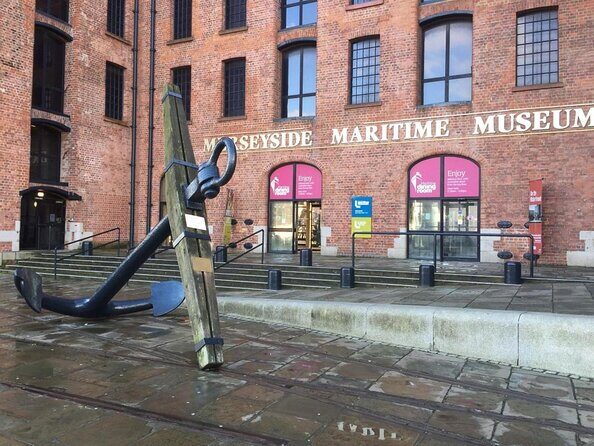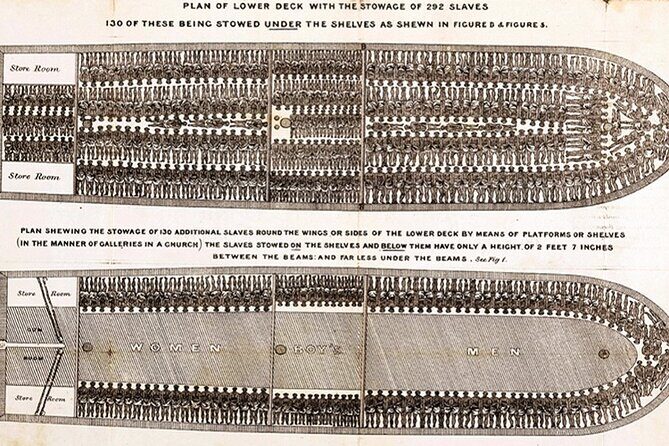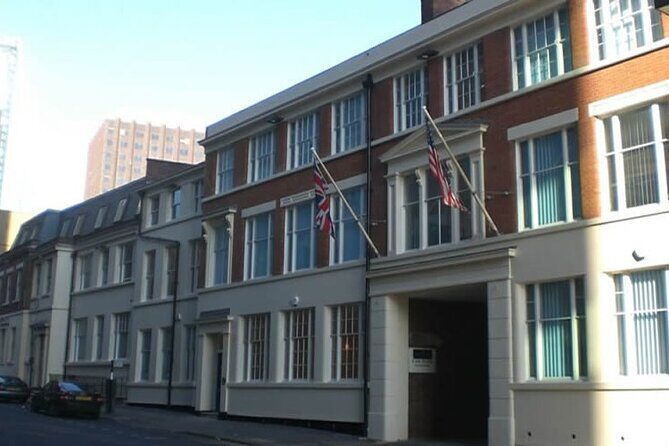Engaging Introduction

Exploring Liverpool often conjures images of The Beatles or its iconic waterfront, but this Liverpool Slavery Walking Tour – Commercial Side takes you on a different kind of journey—one that reveals the city’s dark past linked to the transatlantic slave trade. For $38.29 per person, over roughly two hours, you’ll walk through the original seven streets of Liverpool, uncovering the buildings and places where the city’s wealth was built on the backs of enslaved Africans. Led by guides who bring both insight and a respectful tone, this tour offers a compelling look at how Liverpool’s history is woven into its architecture, commerce, and even its churches.
Two elements stand out immediately. First, the detailed storytelling about Liverpool’s role in the slave trade, including visits to sites like the Exchange Flags and Liverpool Water Street, helps you understand the depth of this history. Second, the focus on specific locations connected to merchants, banking, and shipping provides a tangible sense of how wealth was accumulated and the moral questions that come with it.
A possible consideration is that this tour is quite comprehensive and packed with stops—some visitors might find it a bit intense or demanding, especially if they want a more relaxed pace. Also, while the tour covers a lot of ground, you might need to reserve your visit to the International Slavery Museum at the end, which is free but optional.
This experience is perfect for history buffs, those interested in Liverpool’s lesser-known stories, or travelers seeking a more authentic and thoughtful perspective on the city’s heritage. If you’re curious about how London’s most famous banking institutions and Liverpool’s maritime might are connected to difficult chapters in history, this tour will resonate.
Key Points
- Insightful guides deliver detailed stories about Liverpool’s involvement in the transatlantic slave trade.
- Historical sites include important buildings like the Cotton Exchange and Liverpool Town Hall.
- The tour offers visual aids such as photographs to bring the stories to life.
- Walking through the original streets and docks provides a powerful sense of place.
- The optional visit to the International Slavery Museum adds a deeper understanding.
- Group size is limited to 12, maintaining an intimate and engaging experience.
If you're drawn to exploring Liverpool on foot, we've looked into these other walking experiences
In-Depth Review of the Liverpool Slavery Walking Tour

The Itinerary and Its Significance
The tour begins at the Liver Building on Pier Head, a fitting starting point given Liverpool’s maritime importance. Over the next two hours, you’ll visit more than a dozen stops, each offering insights into different facets of the city’s connection to slavery, trade, banking, and shipping.
The first stop, Our Lady and Saint Nicholas Church and Garden, is more than just a picturesque site. Many slave traders worshipped here and are buried in its yard. It’s a poignant reminder that behind the wealth and power, there were often personal stories and moral complexities. The guide’s mention of these traders’ lives helps contextualize the moral weight of the trade.
Moving to the Hargreaves Building, you’ll learn about William Brown, the founder of the Bank of Liverpool and Brown & Shipley Merchant Bankers, connecting Liverpool’s banking roots directly to the trade. The mention of the Cotton Broker emphasizes how Liverpool’s wealth was built on commodities like cotton, which fueled the trade in enslaved Africans.
At Tithebarn Street, the tour touches on Liverpool’s darker collaborations with the Confederate States during the American Civil War, including spying networks and weapon supplies. It’s a stark reminder that Liverpool’s influence extended beyond Africa and into US history.
The Cotton Exchange Building stands as a testament to Liverpool’s dominance in cotton trading. You’ll learn how “Liverpool Rules” continue today, showing how old practices have lingering echoes. The Exchange Flags area is where slaves were sold, and the guide’s stories help you grasp the scale of human suffering behind material wealth.
The Memorial to Sir Alfred Lewis Jones offers a look at one of Liverpool’s most influential figures, whose wealth came from shipping and trading in Africa and the Americas. His philanthropy, including funding the School of Tropical Medicine, demonstrates how some benefitted from the trade while supporting public health initiatives.
Walking along Liverpool Water Street, you’ll see banking buildings that point to the city’s financial might, built on the profits of the trade. The Martin’s Bank Building and old Bank of Liverpool serve as architectural symbols of this prosperity.
As you pass Dale Street, you’ll walk through streets that have preserved their 18th-century charm, including a pub that might have hosted early slave traders. The narrow passageways evoke a sense of history, and the story of the Liverpool Castle stones used in docks ties the city’s development directly to maritime commerce.
Castle Street is another highlight, with its buildings linked to merchants, slavery, and the Bank of England’s first branch outside London. The Queen Victoria Monument and site of Liverpool Castle add historical layers to your walk.
The Liverpool Town Hall reveals the civic pride of the city, with its architecture and friezes depicting African figures—an uncomfortable but important reminder of the city’s historical ties.
The visit to Graving Docks provides a tangible connection to the practical side of ship repair for vessels involved in the slave trade, while passing by the Merseyside Maritime Museum offers an opportunity for further exploration at your own pace.
Finally, walking through Salthouse and Canning Docks and the site of Liverpool’s Old Dock, built by Thomas Steers in 1715, underscores how infrastructure innovations fueled Liverpool’s African and transatlantic trade.
The Experience of the Tour
The tour’s small group size (maximum 12 travelers) creates an intimate environment where questions are encouraged. Guides, such as Edward and Tommy, are praised for their knowledge and ability to connect stories with visual references—including photographs that bring history to life. As one reviewer shared, “Edward explained that while few slaves actually [were] at the sites, the stories behind these buildings tell the broader story.”
The pace is brisk but manageable, with each stop lasting around 10 minutes, giving enough time to absorb details without feeling rushed. The walking route along cobbles and narrow streets adds an authentic feel but does require comfortable footwear.
A notable point made by visitors is how the tour reveals Liverpool’s true complexity—a city whose prosperity was built on morally ambiguous foundations. The stories of slave traders worshipping at churches and buildings that served as auction sites provide a nuanced understanding that often gets overshadowed by more celebratory histories.
The Value of the Tour
At $38.29, the price might seem steep for just two hours, but when you consider the depth of storytelling, the historical sites visited, and the insights gained, it’s well worth the investment. The tour offers a more layered understanding of Liverpool than typical sightseeing walks—and it challenges you to reflect on how history shapes modern cities.
The optional visit to the International Slavery Museum at the end, which is free, is an added bonus for those wanting a deeper dive. Plus, the small group size ensures personal attention and the chance to ask specific questions.
Who Will Love This Tour?
This walk is best suited for history enthusiasts, questioners, and travelers interested in social justice. If you appreciate guided storytelling with a focus on specific buildings and their stories, you’ll find this tour engaging. It’s also a good fit for those who want to learn about Liverpool beyond the Beatles and waterfront—an eye-opening exploration of the city’s moral and economic legacy.
Final Thoughts

The Liverpool Slavery Walking Tour offers a thought-provoking, detailed view of the city’s involvement in one of history’s darkest chapters. Guided by knowledgeable storytellers, it turns architecture and streets into a narrative of commerce, morality, and change. While the tour packs in many sites and stories, it does so in a way that keeps the experience lively and engaging.
If you’re interested in Liverpool’s maritime and banking history, or eager to see the city from a more critical perspective, this tour is an excellent choice. It’s a chance to walk through history—aware of its complexities—and to leave with a deeper understanding of how the past influences the present.
Frequently Asked Questions

How long does the tour last?
The tour runs for approximately 2 hours, covering multiple sites along Liverpool’s original streets and docks.
What is the cost of the tour?
It costs $38.29 per person, which includes some admission tickets and the guided experience.
Where does the tour start and end?
It begins at the Liver Building Pier Head and ends at 2 Custom House Place near Liverpool’s Old Dock.
Is the tour suitable for all ages?
Most travelers can participate, but be prepared for some walking on cobbles and narrow streets. It’s best for those comfortable with a bit of physical activity.
Are tickets required in advance?
Yes, booking is recommended, typically 12 days in advance, and the minimum booking is for two people.
Can I visit the International Slavery Museum after the tour?
Yes, it’s located near the tour’s endpoint and can be visited free of charge at your convenience.
Is there an opportunity for questions during the tour?
Absolutely—guides are praised for their knowledge and friendliness, often answering questions and sharing extra details.
Are the stops wheelchair accessible?
The tour involves walking on streets and docks, so accessibility may vary depending on the site.
What should I wear?
Comfortable walking shoes are recommended, especially given Liverpool’s cobbled streets and docks.
In choosing this Liverpool Slavery Walking Tour, you select a meaningful, eye-opening experience that offers authentic insights into the city’s past. It’s perfect for curious travelers ready to look beyond the surface and understand the stories behind Liverpool’s famous streets and buildings.
More Walking Tours in Liverpool
More Tours in Liverpool
- Private City Tour – Liverpool
- Liverpool: Beatles Highlights Walking Tour
- Liverpool: Liverpool Football Club Museum and Stadium Tour
- Inspirational Women: Liverpool Past/Present History Tour
- Liverpool: Bill Shankly Kith & Kin Tour with Shankly Family
- Liverpool: Bastion of Invincibility Tour with Shankly Family
More Tour Reviews in Liverpool
More Liverpool experiences we've covered
- Private City Tour – Liverpool
- VEGAS Tribute Acts & Drag Queens | FunnyBoyz Liverpool
- From Liverpool: Full-Day Yorkshire Sightseeing Adventure
- Liverpool: 1-Day Liverpool Pass for Top Attractions
- Liverpool: Beatles Highlights Walking Tour
- Liverpool: Liverpool Football Club Museum and Stadium Tour
- Inspirational Women: Liverpool Past/Present History Tour
- Liverpool: Bill Shankly Kith & Kin Tour with Shankly Family
- Liverpool: Bastion of Invincibility Tour with Shankly Family
- Liverpool Football Club: Legends Q&A and Stadium Tour
- Liverpool: City Walking Tour & Exploration Game
- Liverpool: Lake District Tour with Lake Cruise & Train Ride
